Sensory Wall Fun – Key Takeaways
- Select a location for the sensory wall where your child spends a significant amount of time and is easily accessible.
- Gather tactile materials like buttons, sandpaper, pom poms, and natural items to stimulate the senses and foster exploration.
- Attach diverse tactile materials to a large bulletin board or cardboard, incorporating elements like artificial grass and seashells.
- Create engaging sensory experiences with elements like velcro boards with various textures and a marble run for exploration and learning.
Understanding Sensory Walls
Sensory walls play a pivotal role in child development, providing tactile sensory input that stimulates children’s fingers and hands. This stimulation enhances their learning readiness, promotes calmness and focus, and fosters problem-solving skills and language development.
Sensory walls are engaging and educational resources that enable children to explore their senses. They are constructed from various textured materials, such as buttons, sandpaper, pom poms, and fabric, which capture children’s curiosity and drive them to improve their attention span.
These playful and creative tools benefit children of all ages by encouraging fine motor skills, enhancing their readiness to learn, and stimulating calmness and focus.
Parents can use sensory walls to provide meaningful sensory experiences for their children, fostering their problem-solving capacities and aiding language development.
Starting Your Creation Process
Initiating the creation process of your at-home sensory wall involves a few key steps.
To begin with, choose a suitable location that is easily accessible to your child.
To encourage exploration and learning, gather the necessary materials, including various textured objects, and attach these sensory elements to your chosen wall.
Choosing the Right Location
Selecting the perfect spot for your sensory wall is the first vital step in this creative process, with a location within your child’s reach being ideal for their exploration and interaction. This location should be part of your home where your child spends a significant amount of time interacting with the sensory wall frequently.
When choosing a location, consider hanging a large bulletin board or pieces of cardboard on the wall for the project. This will provide a sturdy yet flexible surface to build your sensory wall. Ensure the location is easily accessible and safe for your child to freely explore the textures and materials on the sensory wall without any risk of injury.
Creating a designated area for the sensory wall promotes a sense of ownership for your child and ensures they can explore at their own pace. The correct location is essential in maximizing the benefits of the sensory wall in your child’s sensory exploration. Understanding your child’s needs and the layout of your home will guide you in finding the best spot. Remember, the goal is to create a stimulating and safe environment for your child.
Gathering Necessary Materials
Gathering a range of tactile materials is the next crucial phase in crafting your child’s sensory wall. This valuable project allows your child to explore and learn from various textures and sensations. A thoughtful selection of materials is required to offer tactile stimulation and inspire curiosity while ensuring safety and durability.
The sensory wall you’re creating should be a rich tapestry of textures that your child can touch, feel, and explore. You’ll need to gather various objects with different textures to achieve this.
Here to achieve this are a few suggestions:
- Buttons, which can be of various sizes and shapes, provide a distinct feel.
- Sandpaper offers a rough texture for contrast.
- Pom poms, these soft, fluffy objects, can be a delightful sensory experience.
Crafting a sensory wall is a labor of love, aiming to create an engaging, educational, and entertaining environment for your child. It’s a tangible expression of your commitment to nurturing their growth and development. Remember, the goal is stimulating their senses and fostering exploration, so let your creativity guide you.
Attaching Sensory Elements
Having gathered various tactile materials, the next step in your sensory wall creation process involves attaching these diverse elements to your designated wall area. Various textured objects like buttons, sandpaper, pom poms, and yarn can be glued randomly. This adds visual interest and creates a sensory-rich experience for your child.
Consider incorporating elements like artificial grass, seashells, velcro, and Koosh balls to provide a range of tactile input. These offer unique feelings under the fingertips and can encourage exploring and discovering different textures. This way, the sensory wall is an engaging learning tool, enhancing your child’s understanding and recognition of various textures.
Consider using a bulletin board or cardboard to attach sensory elements easily. This allows for flexibility in positioning and rearranging the elements, offering new and engaging tactile experiences.
Remember, the aim is to provide a platform that encourages curiosity, learning, and sensory interaction. Your child’s interaction with the sensory wall should bring joy, discovery, and a sense of accomplishment.
Remember to be patient and creative in this process, as it is a labor of love for your child’s development.
Hanging the Base
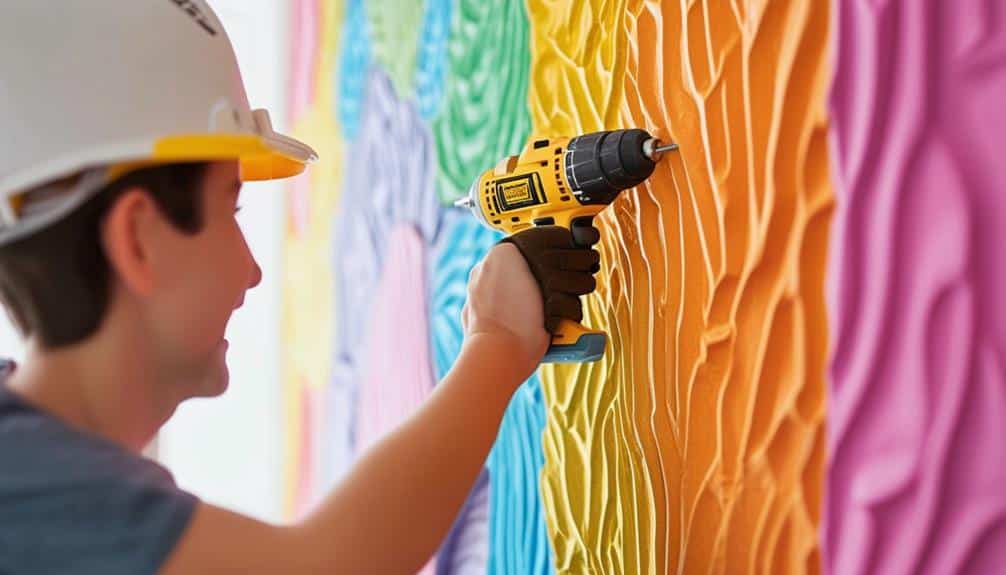
Where in your home can you set up a sensory wall that is easily accessible for your child? The key to creating an effective sensory wall is finding the right place to hang the base, such as a large bulletin board or sturdy pieces of cardboard. This location should be within your child’s reach and in an area where they frequently spend time, making the interactive sensory experience easily accessible and enjoyable for them.
Once you have identified the best area, securely hang your chosen base. This process involves several considerations:
- The base should be robust, providing a safe and reliable platform for the tactile objects.
- It must also be at an appropriate height, allowing your child to engage with all the elements comfortably.
Ultimately, make sure the area around the sensory wall is safe, with soft flooring or mats to prevent injuries from accidental falls.
Attaching Sensory Objects
Now that the foundation of your sensory wall is securely installed, it’s time to enrich it by attaching various textured objects that will stimulate your child’s senses.
The process begins with you selecting various sensory objects, such as buttons, sandpaper, pom poms, and seashells. By adding different tactile elements to the sensory wall, you aim to create a rich sensory experience.
Use a strong adhesive such as glue to secure these items onto the wall. Remember, these objects should be arranged randomly to encourage your child’s curiosity and exploration.
Other items to ponder for tactile exploration are yarn, artificial grass, velcro, and Koosh balls. These provide different touch sensations and invite your child to engage with the wall meaningfully.
Adding furry fabric and colorful textures can further enhance this sensory-rich experience. The key is providing various engaging objects to capture your child’s interest and stimulate their senses.
Creating Themed Walls
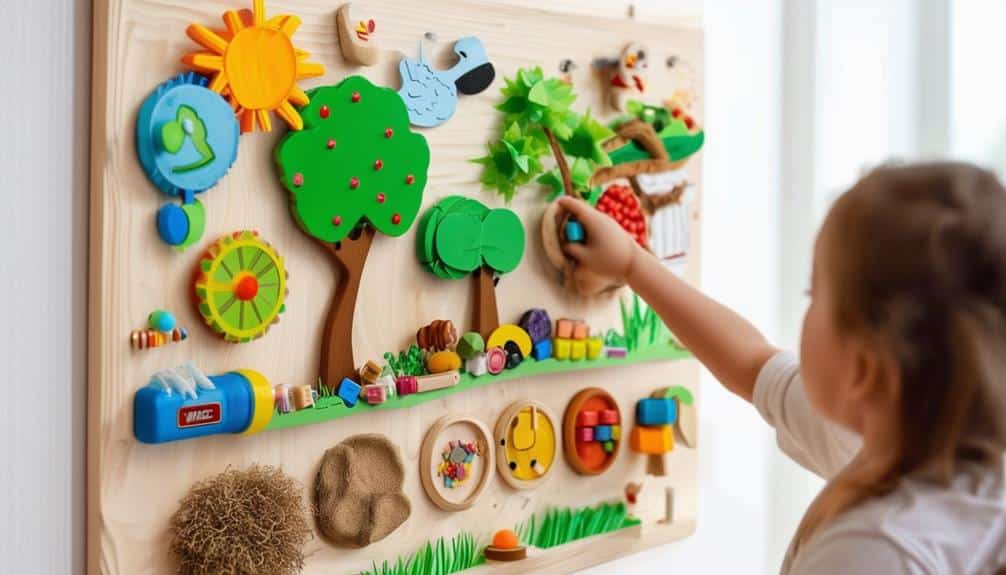
To further enhance your child’s sensory exploration, consider creating themed walls that are interactive, engaging, and tailored to your child’s interests. A themed sensory wall offers a personalized experience, with engaging activities designed to stimulate their imagination and foster their development.
For instance, a Mermaid Sensory Wall may include:
- Locks & latches to enhance fine motor skills
- A whiteboard to express creativity and thoughts
- Velcro boards with various textures for sensory stimulation
These components facilitate sensory interaction and cater to your child’s fascination with the theme.
Tailoring the sensory wall according to your child’s interests reinforces their sense of ownership and engagement. Whether their interest lies in animals, outer space, or fairy tales, themed walls offer endless possibilities for imagination and learning.
Engaging Sensory Experiences
Engaging in sensory experiences with your child promotes exploration and discovery and fosters a strong bond between you both. These experiences provide a natural platform to model touching and feeling different textures with a positive attitude. Doing so creates an environment where tactile exploration is not just allowed but actively encouraged.
Children learn best in an interactive environment. An at-home sensory wall can create such an environment, stimulating their senses and promoting engagement. It’s a hands-on tool that nurtures curiosity and invites children to explore through sensory play.
Another advantage of sensory experiences is that they boost language skills. Narrating descriptive words during interaction with the sensory wall can help your child develop a more extensive vocabulary. For example, you can describe the texture of a material as rough, smooth, slippery, or soft.
Further, sensory play promotes problem-solving skills and fine motor muscle development. Activities such as sorting objects by texture or color can improve these abilities.
Lastly, remember that a sensory wall should be a positive space. It’s not just about learning; it’s about creating a safe, interactive environment that can help calm and recenter your child when needed. Thus, engaging sensory experiences can be both educational and therapeutic.
Resources for Assistance
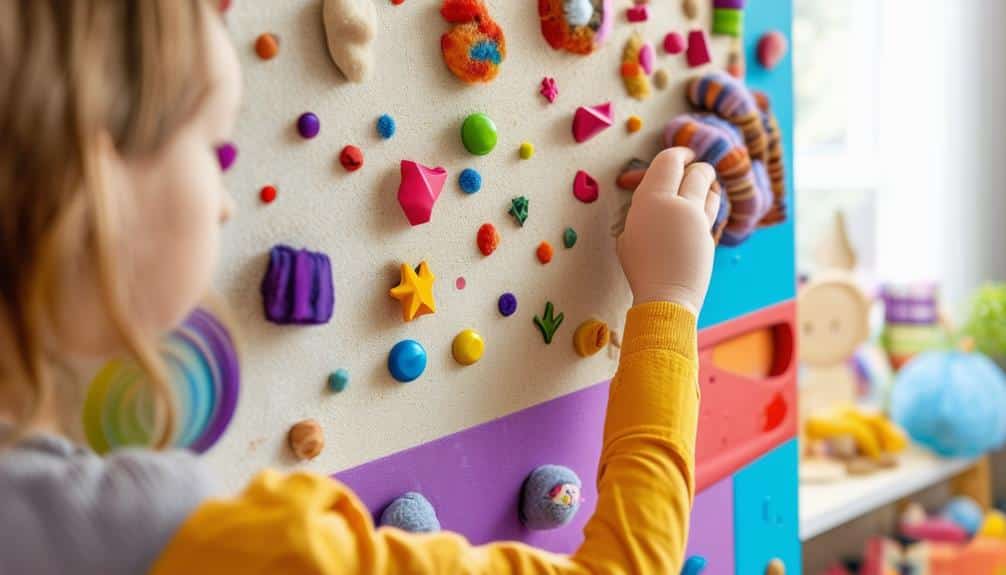
Finding the right way to create an at-home sensory wall can be challenging, but fortunately, several resources are available to assist. TherapyWorks, for example, offers invaluable services such as Speech Therapy, Feeding Therapy, Occupational Therapy, and Social Work.
In addition, they offer guidance in creating stimulating at-home activities like sensory walls, ensuring that your child’s development and well-being are well-supported.
Identifying Reliable Resources
When exploring sensory development solutions for your child, reliable resources such as TherapyWorks offer a range of services through teletherapy, including Speech Therapy, Feeding Therapy, Occupational Therapy, and Social Work services. These experts provide invaluable insights to help manage sensory processing disorder, which can significantly enhance your child’s interaction with their environment.
- Teletherapy offers an exceptional opportunity to evaluate and cater to your child’s sensory needs in their natural surroundings, creating an environment of comfort and familiarity.
- Occupational Therapy assists in identifying sensory tools that can facilitate your child’s sensory processing skills.
- The therapists can guide you in creating sensory activities at home, such as sensory walls, which aid development and develop a sense of fun and excitement.
Therapists and Sensory Walls
Building on the support offered by TherapyWorks, parents can further enhance their child’s sensory experience by creating a sensory wall at home. Combining professional guidance and at-home activities, this innovative approach fosters an enriched environment for children, particularly those grappling with sensory processing or delicate motor skill concerns.
Therapists play an integral role in this process. Therapists evaluate a child’s skills in their natural environment through teletherapy sessions for a more accurate assessment. This insight enables them to guide parents in creating tailored sensory walls that address their child’s specific needs.
Beyond merely creating a playful space, these sensory walls offer therapeutic benefits, enhancing a child’s sensory experiences and development.
However, while parents’ efforts are commendable, professional help is often essential. Therapists possess the necessary expertise to understand a child’s sensory needs and can offer invaluable advice on addressing them. Engaging with therapists and implementing their recommendations can significantly enhance the benefits of at-home sensory walls for children.
Online Sensory Wall Guidance
To enhance the success of at-home sensory walls, TherapyWorks offers detailed online guidance, providing resources such as teletherapy services, step-by-step instructions, and tailored advice. These resources are instrumental in providing a roadmap for parents and caregivers, enabling them to create an engaging, beneficial sensory space for their child.
This online guidance includes a plethora of resources:
- Teletherapy services that evaluate your child’s sensory needs and recommend suitable sensory wall activities.
- Step-by-step instructions to guide you through the process of setting up your at-home sensory wall.
- Tailored advice during virtual consultations with therapists, ensuring your sensory wall is customized for your child’s needs.
These resources offer a helping hand in creating a sensory wall, ensuring it is a beneficial, enjoyable experience for your child. They are designed with empathy and practicality, serving your child’s developmental needs while empowering you to provide the best possible support. Creating an at-home sensory wall with this online guidance becomes a manageable, rewarding task.
Sensory Room Essentials
Creating a sensory room for your child entails incorporating key elements that provide a variety of sensory stimulation. These include a bubble tube, acrylic mirrors, plastic slide, glow-in-the-dark sensory bin, and comfortable crash pad. These sensory room essentials cater to your child’s sensory preferences, delivering tactile, visual, and proprioceptive input in a controlled and engaging environment.
A reasonably priced bubble tube on Amazon emits soothing colors and movements, offering visual and sensory stimulation. Acrylic mirrors provide an immersive experience, enhancing spatial awareness and encouraging self-recognition. The plastic slide serves as a tool for proprioceptive input, facilitating the child’s understanding of their body and surroundings.
The glow-in-the-dark sensory bin is a fun addition. It is filled with white rice and neon paint, providing a distinct tactile experience. A comfortable crash pad, also available on Amazon, completes the setup and makes for a perfect lounging spot.
While not mentioned in the list above, weighted blankets are also an excellent sensory tool, providing deep pressure that can be calming and comforting.
Sensory Room Lighting

Incorporating appropriate lighting within a sensory room influences the overall sensory experience, offering a myriad of personalized and calming visual effects tailored to a child’s specific sensory needs. Sensory room lighting is an essential element that enhances visual stimulation, creating a therapeutic and engaging environment.
Several adjustable lighting options can be considered to create a sensory-rich setting:
- Fiber optic lights provide customizable lighting effects, allowing for a calm and soothing ambiance.
- With their fluorescent and glow-in-the-dark capabilities, black light fixtures can introduce an element of surprise and excitement.
- Introducing colorful lights can heighten visual stimulation, making the room vibrant and engaging.
These lighting options offer control over brightness levels, catering to individual sensory preferences.
Investing in suitable sensory room lighting will guarantee a fulfilling sensory experience for your child, positively impacting their overall well-being and sensory development. Remember, creating a space that serves your child’s specific needs and preferences is the goal.
Sensory Room Furniture
Beyond the lighting domain, selecting the appropriate sensory room furniture is pivotal in fostering an environment that provides children with comfort, sensory input, and tactile stimulation. Different types of sensory room furniture cater to various needs and preferences.
Weighted blankets, for example, offer a calming effect by delivering pressure that can help children feel secure. Crash pads provide a safe space for children to jump, roll, and play, promoting physical activity and sensory integration. On the other hand, sensory bean bag chairs are versatile pieces that serve as comfortable seating options and provide tactile stimulation.
Choosing the right furniture requires careful consideration of your child’s distinct needs. It’s essential to create a balance between stimulating and calming elements.
| Furniture Type | Purpose |
|---|---|
| Weighted Blankets | Provide calming effect |
| Crash Pads | Promote physical activity |
| Sensory Bean Bag Chairs | Offer comfort and tactile stimulation |
Investing in quality sensory room furniture can significantly enhance your child’s sensory experience at home. With thoughtful selection, your sensory room can be a haven of comfort, stimulation, and exploration for your child.
Sensory Room Decor
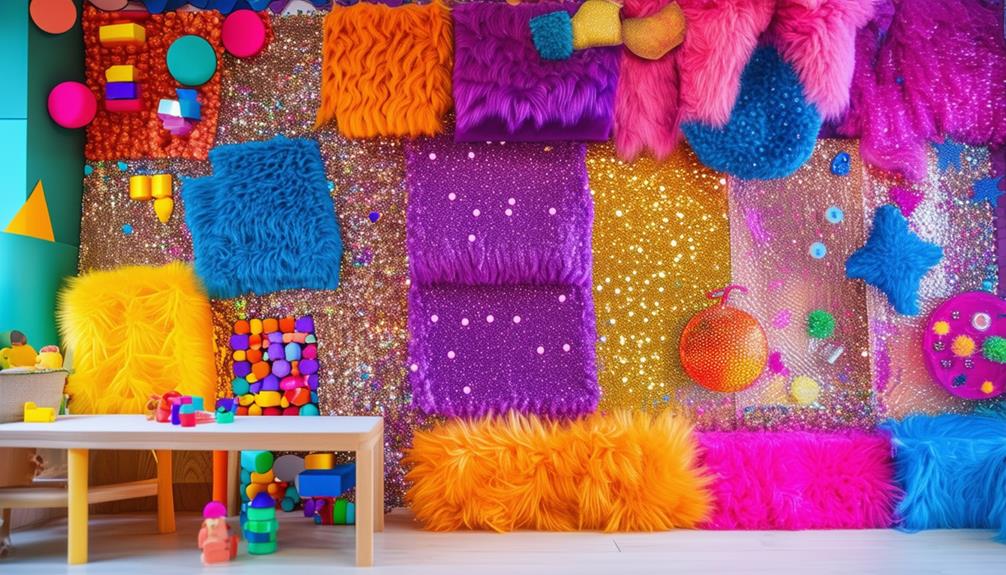
When designing a sensory room, the decor plays a significant role, encompassing elements such as wall decals, sensory wall panels, ceiling mobiles, curtains, and rugs, all targeted to stimulate the visual, tactile, and auditory senses while creating a comfortable and engaging environment for your child. This sensory room decor is carefully selected to provide your child with a stimulating and nurturing space.
- Wall decals add visual interest and stimulate the child’s imagination. They can also introduce colors, shapes, and themes your child finds soothing or engaging.
- Sensory wall panels are tactile surfaces that encourage exploration and touch, providing tactile input that enhances your child’s sensory experience.
- Ceiling mobiles are essential for visual stimulation and can engage the auditory senses with gentle sounds.
Organizing Your Sensory Room
After choosing and setting up your sensory room decor, it’s essential to focus on organizational strategies to maximize the room’s effectiveness and utility.
One critical step to organizing your sensory room involves using storage containers. These are perfect for storing sensory toys and tools, ensuring they’re always accessible but out of the way when unused. Keep the space tidy to maintain a calm, distraction-free environment for your child.
Another helpful strategy is to implement a labeling system. By clearly marking storage containers, you can quickly locate specific items. This system saves precious time and minimizes disruptions during your child’s sensory sessions.
It’s recommended that you create a rotation schedule for the sensory toys. This will introduce variety for your child, preventing sensory overload and keeping their interest alive. Regularly changing the toys allows you to clean and maintain them, prolonging their lifespan.
Lastly, optimize the room’s layout to promote movement and exploration. Establish different sensory zones for various activities, encouraging your child to engage with the environment in diverse ways.
This thoughtful organizing of the sensory room creates a customized, efficient space for your child’s development.
Frequently Asked Questions
Is It Possible to Create a Sensory Wall Suitable for Indoor and Outdoor Use?
A sensory wall can be designed for indoor and outdoor use. Appropriate materials resistant to weather changes should be used for outdoor walls to guarantee longevity and safe sensory exploration.
How Often Should I Update or Change the Sensory Items on the Wall?
Updating or changing sensory items on the wall should ideally occur every few weeks. Regular refreshment keeps the sensory experience engaging and stimulating for the child, supporting their ongoing sensory development and exploration.
Can a Sensory Wall Be Beneficial for Children Without Sensory Processing Issues?
Yes, a sensory wall can be beneficial for all children. It promotes exploratory learning, fine motor skills, and cognitive development. It’s an enjoyable, interactive tool that fosters curiosity, irrespective of sensory processing abilities.
Are There Any Specific Safety Measures to Consider When Installing a Sensory Wall?
Yes, safety is paramount when installing a sensory wall. Confirm all materials are safe, edges are smooth to avoid injury, and wall fixtures are secured tightly to prevent them from becoming potential hazards for children.
Can I Incorporate Technology, Like Tablets or Interactive Screens, Into a Sensory Wall?
Incorporating technology like tablets or interactive screens can enhance the sensory experience. However, ensure they are securely mounted and have protective covers to prevent damage and ensure child safety.
Conclusion
Creating a sensory wall at home is like painting a canvas of sensory exploration. This interactive activity can help your child develop their cognitive skills and sensory systems. Using pipe cleaners, water beads, and tissue paper, you can provide hours of fun while boosting their sense of touch and hand-eye coordination.
Sensory walls also improve motor skills and balance by offering different textures and activities. Incorporate sandpaper, yoga balls, and a balance beam to challenge their vestibular input and coordination. These fun activities can turn any space into a sensory haven, helping your child thrive and feel comfortable in their environment.
Parents can use sensory wall ideas to create a space that matches their child’s sensory preferences and developmental needs. The possibilities are endless, from sensory bottles filled with water and drops of food coloring to tactile experiences with cotton balls and kinetic sand. This guide aims to help you design a sensory space that supports your child’s sensory development and enhances their learning journey.

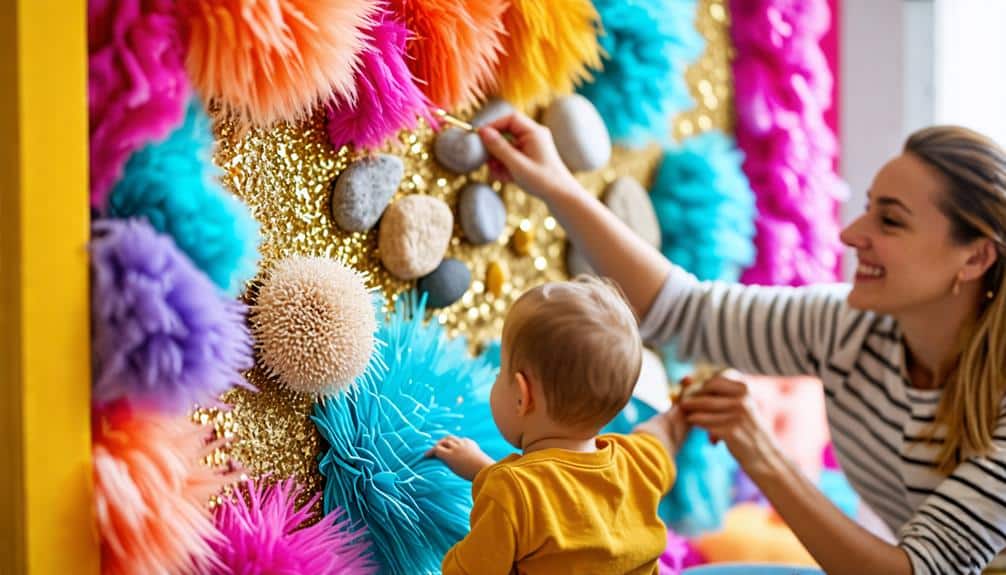
Recent Comments